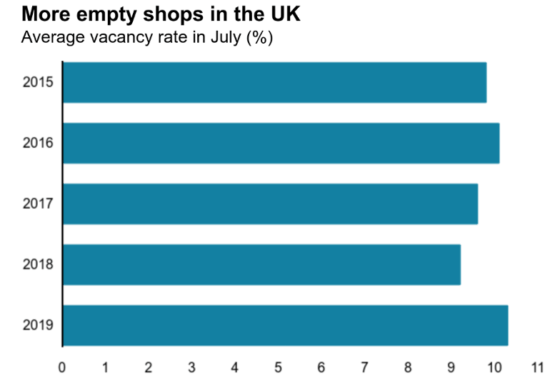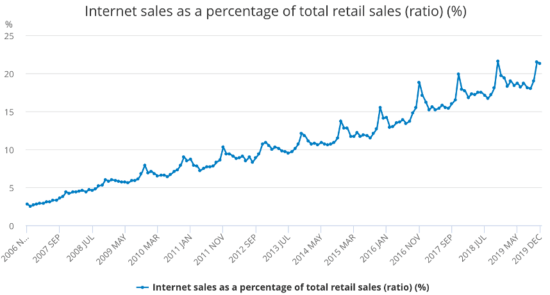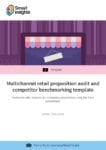A three-step approach for standing out and being distinctive in the retail space
It’s no secret that we’re experiencing a high street retail crisis in the UK. According to the Centre for Retail Research, there are around 50,000 fewer shops on our high streets than just over a decade ago, with some predicting this will only get worse in the following years.
The number of empty shops stands at a record high. In July 2019 the proportion of all shops that are empty reached 10.3%, its highest level since January 2015:

[Image Source]
There are many reasons why high street retailers are suffering, including:
- Changing consumer tastes – whilst chain stores have declined on the high street, PWC has reported that charity shops and takeaways are two categories experiencing growth.
- Declining footfall – visitors to UK stores fell by 10% in the last seven years according to BRC/Springboard.
- Job cuts – according to the British Retail Consortium, UK retail lost 106,000 jobs between March 2016 to 2019.
Of course, the rise of online is another major factor that has influenced the way consumers shop. Amazon, in particular, has single-handedly changed the way we think about and experience shopping. We now expect products at low prices, delivered quickly, and at a convenient time and place. If it’s quick and easy to buy online with just the click of a button, why bother going to a physical store?
But it’s worth noting that whilst online retail sales have been steadily growing over the last 15 years, internet shopping only accounts for around 21% of total retail sales.

[Image Source]
Although Amazon, Apple, and other online-only retailers are impacting physical retail stores, this by no means explains the overall decline (note that John Lewis, Tesco, and Marks & Spencer are three of the largest online stores in Europe). The conversation should be less about how you compete online with Amazon and more about how to complete with retailing as a whole.
Stand out and make a difference
In 2018, Forbes’s Steve Dennis declared that it isn’t physical retailing but boring retail that’s dead and that this is a result of brands getting stuck in the middle. Whilst this was once an area of strength (consider British Home Stores or Woolworths, selling a huge range of products all under one roof), being something to a lot of people but ultimately not much to any of them is now a recipe for failure.
The key to success in retail today is to offer consumers something different and add value in ways that other online stores simply can’t. If you want to attract prospective customers into your store (online or offline) you simply have to provide a differentiating advantage and a unique retail experience. Brands such as made.com and Fartech are now opening physical stores, and Joules, Pets at Home and Screwfix are all retail winners in the UK.
In January, I blogged about research conducted by McCann that revealed the new ‘truths’ of commerce against the backdrop of three fundamentals that have remained consistent over the last four years:
- The joy of discovery
- The pleasure of great customer service
- The satisfaction of convenience
Whilst this research provides a clear overarching view of where retailers should focus their efforts, the next step is to look at the practical implications of this insight. According to Will Lockie, Global Head of e-commerce at Georg Jensen, retailers today need to think about how they can both find and execute an advantage over the dominant e-commerce giants such as Amazon. To do this, brands need to three-step approach:
Hygiene
Before you can start thinking about implementing anything truly different from the competition, you must first take a close look at what you’re currently doing and ensure you are doing the basics well. The 2015 world cup winning All Blacks team is regarded as one of the greatest of all time. But it’s widely agreed that the key to the New Zealand team’s remarkable success was their ability to do the basics well.
Consumers today expect a baseline level of capabilities from retailers (e.g. ‘table stakes’) so it’s important to get these right:
- Quick and flexible payment options.
- Detailed product information, including story, design, and origin.
- Fast and convenient delivery options.
- A distinctive, joined-up brand experience across multiple channels.
If you don’t get these ‘hygiene’ factors right you’ll be on the back foot, whereas success in this area will give you a platform to layer on additional capabilities. Will Lockie provides some helpful principles to follow when evaluating your choices:
- Focus on what works for your brand
- Simplicity and convenience always win
- Remove any barriers so you are ‘easy to shop’
- Focus on solving customers’ problems
- Be distinctive
Difference
Mastering the basics will give you a solid foundation, but in order to really stand out from the retail behemoths, you need to have a compelling brand story that can work over the long-term. This is something that McCann identified as part of their truth about retail research when they talk about creating meaningful retail relationships.
Being clear about your brand purpose and point of difference is key to attracting customers and reminding existing customers why they already shop with you. Think about the space you own as a brand that differentiates you from everyone else.
WHSmith is often seen as a dull, tired UK retailer. And yet Smiths, a British institution, is actually a major high street success story. The rise of Amazon, so damaging to brick and mortar retail, should pose a major threat to WHSmith’s sales of books, magazines, stationery, and gifts. Yet the brand has seen major growth by owning the travel sector (just consider Smith’s prevalence in airports and railway stations).
To compete with the major retailers, Will Lockie recommends asking the question “what can’t Amazon do?”:
- What value can you add without discounting?
- What additional content can you include about your products and/ or services?
- How can you weave storytelling into the customer experience?
- What unique customer insight or data can you leverage?
- What utility can you provide to customers? How can you solve their problems and be genuinely useful as a brand?
Marks and Spencer’s complimentary bra-fitting service and Starbucks’s order and pay service are two examples of brands being useful for customers by serving that core purpose beyond ‘selling’. What can you do to be useful for customers in a new and different way?
Customer
Being ‘customer first’ is easy to say but very difficult to do (and maintain consistently) in practice. It’s a mantra you’ll hear every brand recite, yet to be truly customer-first you need to get the basics right, find a point of difference and genuinely listen to your customers.
Will Lockie sums this up nicely: “Customers don’t choose a product or service based on what you tell them, but based on what they experience”. This means that understanding and measuring customer satisfaction, listening to customer feedback and building these principles into your systems and technology are becoming increasingly important.
With 86% of consumers willing to pay more for better customer experience, retailers who ignore the voice of the customer will find themselves at a significant disadvantage.
Conclusion
The retail experience in the UK is fracturing, with high streets seeing an increase in empty shops and declining footfall, largely due to changes in consumer tastes and job cuts, Whilst consumers are spending more time online, this only goes some way to explaining retail’s travails. The most likely cause is a lack of imagination, with many retailers failing to execute a differentiating customer experience.
Retailers, whether online, offline or a combination of the two, should focus on providing a shopping experience that excels at the basics, tells a meaningful brand story and meets customer expectations by listening to feedback and putting the voice of the customer into everything they do.
Source link



